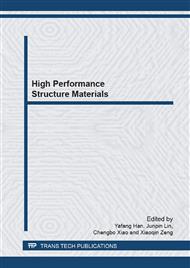[1]
Hong Wang, Rui Liu, FengJi Cheng. Electrodepositing amorphous Ni-W alloys for MEMS. Microelectronic Engineering; 2010, 87(5): 1901-(1906).
DOI: 10.1016/j.mee.2009.11.018
Google Scholar
[2]
R. Liu, H. Wang, J.Y. YAO, X.P. Li, G.F. Ding. Preparing Ni-W alloy films with low internal stress and high hardness by heat treating. Surface Review and Letters; 2007, 14(6): 1107-1112.
DOI: 10.1142/s0218625x07010676
Google Scholar
[3]
M. Klimenkov, A.S.M.A. Haseeb, K. Bade. Structural investigations on nanocrystalline Ni-W alloy films by transmission electron microscopy. Thin Solid Films; 2009, 517: 6593-6598.
DOI: 10.1016/j.tsf.2009.04.039
Google Scholar
[4]
A.S.M.A. Haseeb, U. Albers, K. Bade. Friction and wear characteristics of electrodeposited nanocrystalline nickel-tungsten alloy films. Wear; 2008, 246(2): 158-159.
DOI: 10.1016/j.wear.2007.02.004
Google Scholar
[5]
C.N. Panagopoulos, G.D. Plainakis.A. Lagaris. Nanocrystalline Ni-W coatings on copper. Materials Science and Engineering B; 2011, 176(6): 477-479.
DOI: 10.1016/j.mseb.2010.03.058
Google Scholar
[6]
R. Juškėnas, I. Valsiūnas, V. Pakštas, R. Giraitis. On the state of W in electrodeposited Ni-W alloys. Electrochimica Acta; 2009, 54(9): 2616–2620.
DOI: 10.1016/j.electacta.2008.10.060
Google Scholar
[7]
M. Metikoš-Hukovic, Z. Grubac, N. Radic, A. Tonejc. Sputter deposited nanocrystalline Ni and Ni-W films as catalysts for hydrogen evolution. Journal of Molecular Catalysis A: Chemical; 2006, 249: 172–180.
DOI: 10.1016/j.molcata.2006.01.020
Google Scholar
[8]
Timothy J. Rupert, Christopher A. Schuh. Sliding wear of nanocrystalline Ni–W: Structural evolution and the apparent breakdown of Archard scaling. Acta Materialia; 2010, 58(12): 4137–4148.
DOI: 10.1016/j.actamat.2010.04.005
Google Scholar
[9]
P. Choi, T. Al-Kassab, F. Gǎrtner, H. Kreye, R. Kirchheim. Thermal stability of nanocrystalline nickel-18at. %tungsten alloy investigated with the tomographic atom probe. MaerialsScience and Engineering A; 2003, 353: 74-79.
DOI: 10.1016/s0921-5093(02)00670-6
Google Scholar
[10]
S.J. Suresha, M. Haj-Taieb, K. Bade, J. Aktaa and K.J. Hemker. The influence of tungsten on the thermal stability and mechanical behavior of electrodeposited nickel MEMS structures. Scripta Materialia; 2010, 63: 1141–1144.
DOI: 10.1016/j.scriptamat.2010.07.015
Google Scholar
[11]
L.M. Chang, Z.T. Wang, S.Y. Shi, W. Liu. Study on microstructure and properties of electrodeposited Ni–W alloy coating with glycolic acid system. Journal of Alloys and Compounds; 2011, 509(5): 1501-1504.
DOI: 10.1016/j.jallcom.2010.10.136
Google Scholar
[12]
Kung-Hsu Hou, Yun-Feng Chang, Sha-Ming Chang, Chia-Hua Chang. The heat treatment effect on the structure and mechanical properties of electrodeposited nano grain size Ni–W alloy coatings. Thin Solid Films; 2010, 518(24): 7535-7540.
DOI: 10.1016/j.tsf.2010.05.041
Google Scholar
[13]
Bin Gan, Sammy Tin. Assessment of the effectivness of transition metal solutes in hardening of Ni solid solutions. Materials Science and Engineering A; 2010, 527(26): 6809–6815.
DOI: 10.1016/j.msea.2010.06.071
Google Scholar


